Bit providers are busy matching cutters to the formations in which they will be applied and modeling bit path and wear to optimize performance.
Diane Langley, Technology Editor
When it comes to the science of making hole, the industry has been making progress bit by bit. This year is no exception. PDC bits remain the tool of choice for borehole construction; roller-cone and fixed-cutter bits are essentially mature products. Thanks to bit performance improvements, it is now possible to use PDC bits to drill formations that would not have been PDC drillable just 10 years ago. Nevertheless, new reservoirs are smaller, deeper and more difficult to reach, continually increasing drilling costs and pressuring manufacturers to develop bits that can drill farther and faster through hard and abrasive formations.
Bit performance has a huge impact on drilling cost per foot. The drill bit is one of the most important oilfield technologies, and selection of the right bit for the application is one of the most important aspects of reducing drilling costs. True to what was predicted a couple of years ago, bits are being custom-designed to fit particular applications. As one provider told World Oil, providing a great bit with multiple advanced features is not necessarily going to get you a sale. Providing the bit to get the job done safely and efficiently is what customers expect nowadays.
Research and development initiatives are underway to investigate different cutter retention methods and back-rake/side-rake angles that would create optimal side force to rotate the cutter. Other efforts are focusing on the need to understand the interaction between a drill bit and under-reaming tool in bottomhole assemblies. Some bit providers are concentrating on modeling techniques. Simulation software has become very important to successful development of any new bit design. In particular, the continued shift toward horizontal drilling has proved to be a specific key driver in development of PDC bits that have predictable directional properties when drilling varying formation types.
BAKER HUGHES
Baker Hughes reported the first use of stabilized high-aspect-ratio sealed precision bearings. Hughes Christensen Vanguard tricone drill bits (Fig. 1) provide engineers with the flexibility to choose metal- or elastomer-sealed long-life bearings when designing bits appropriate for any tricone application.
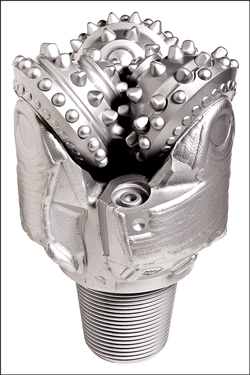 |
|
Fig. 1. Baker Hughes’ Vanguard tricone drill bit.
|
|
Vanguard designs are predicated on balance between bearing, cutters and body integrity. Drilling application review teams closely analyze the application and select the optimum combination of features to create the most efficient and durable bit for a specific formation. Engineered cutters combine application-tuned carbide grades with aggressive tooth shapes for faster rate of penetration (ROP). Mathematical models assist cutter arrangements, reducing tracking and increasing ROP. High-strength legs and enhanced OD protection prevent severe leg wear in directional applications. Elastomer parts rated for continuous service up to 550°F are designed for hot-hole, high-temperature applications.
Vanguard bits are now being used for tough carbonate drilling in the Middle East and to deliver a quality hole in directional applications and for surviving long hours in a geothermal environment.
Performance. Vanguard technology saved an operator 28% in drilling costs over a competitor offset in Oklahoma. An 8¾-in. VMD-33DVHX bit was used to drill curve with one bit in abrasive, layered sandstone followed by shale with chert bands and pyrite nodules. The 8¾-in. bit drilled the curve and 200 ft of lateral, saving 28% in drilling costs through increased ROP and footage drilled, and through the elimination of one bit trip.
Baker Hughes’ Kymera hybrid drill bit (Fig. 2) can aggressively and efficiently drill shale and other formations with problematic plastic, or malleable, characteristics two to four times faster than a roller cone bit. Leveraging the strength of the PDC bit in soft formations and the roller cone in hard formations, the Kymera bit uses technology that can maintain an overall ROP much higher than a roller cone or PDC bit alone. With the synergistic combination of diamond scraping and roller-cone crushing, the bit can survive even in conglomerates. The rolling cutters improve the bit dynamics by reducing torsional oscillations, and the scraping diamond cutters produce a smooth borehole bottom, which reduces bit bounce. Compared to conventional PDC bits, torsional oscillations are as much as 50% lower; stick/slip occurs at lower revolutions per minute (rpm); and whirl is reduced at high rpm.
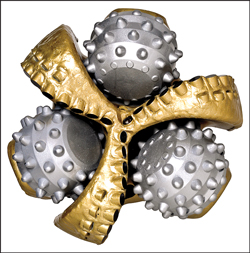 |
|
Fig. 2. Baker Hughes’ Kymera hybrid drill bit.
|
|
HALLIBURTON
Halliburton is addressing increased technical demands to develop bits that can drill farther and faster through ever-harder and more abrasive formations. The company’s FX Series drill bits (Fig. 3) incorporate enhancements to the FM3000 series design platform, including next-generation PDC cutters, optimized hydraulics, new bit body materials and enhanced manufacturing processes.
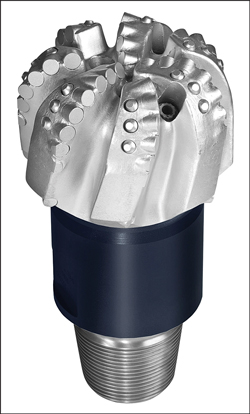 |
|
Fig. 3. Combined seafloor and subsurface models.
|
|
Latest technologies combined. While roller-cone and fixed-cutter bits are essentially “mature” products, recent improvements are being realized with new materials and manufacturing processes. Using better, more erosion-resistant materials from matrix to binder, FX Series bits extend bit life through the long intervals and high flowrates typical of many of today’s most challenging applications. The erosion-resistant bit body and optimized hydraulic configuration reduce erosion for maximum durability.
In addition, FX Series drill bit designs incorporate proprietary, thermally stable and highly abrasion-resistant X3 Series cutter technology. Manufactured with greater thermal stability to withstand heat cycling and resist heat breakdown, X3 Series cutters stay sharp and wear slowly. A stronger diamond table enables the X3 Series cutter to maintain a sharp cutting edge, resulting in greater intervals drilled and faster rates of penetration. According to company literature, X3 Series cutters exhibit enhanced performance of up to four times the intervals drilled.
Finally, the latest design analysis techniques improve accuracy and consistency in Halliburton’s bit production processes, ensuring that design integrity is preserved throughout the manufacturing process. Using sophisticated computational fluid dynamics (CFD) analysis capabilities, each aspect of PDC bit hydraulics can be optimized, guiding design of even the most aggressive configurations, while advanced fluid modeling contributes to better performance through flow control and minimizing bit body erosion.
‘Art to part’ design. In horizontal wells, operators are asking for a bit that can drill the build section at the required build rate and then continue on to drill the lateral section to TD. Designing a bit that can deliver this type of versatility requires advanced understanding of the dynamic downhole conditions that affect all drilling parameters. FX Series bits are designed for optimal directional performance using Halliburton’s advanced Direction by Design software (Fig. 4), which determines the effects of bit geometry parameters on steerability and walk rate for a given bit according to the specific drilling system used.
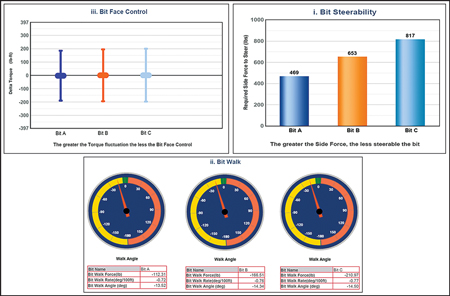 |
|
Fig. 4. Bit performance comparison using Halliburton’s Direction by Design software.
|
|
Direction by Design software meshes specific bit design features and formation characteristics in three dimensions, and simultaneously inputs bit rotation, axial penetration, tilting motion and formation properties to simulate the bit/formation interaction. In terms of directional bit design, this enables designers to predict side force required, walk force and speed in azimuthal direction for a specific bit design in a given drilling application. In addition, bit torque variance during directional drilling is calculated to account for different bit behaviors during kickoff, build and hold drilling modes.
The new cutter/rock interaction model at the software’s heart enables directional drill bits to be designed with optimum bit walk characteristics for drilling a specific wellbore profile with a specific drilling system. As a result, PDC bit designs can be optimized and sent to the field with directional performance attributes already known before the bit is ever run in hole.
Performance. To bring the best bit solution to each application, Halliburton uses the continuous-improvement design optimization process of Design at the Customer Interface (DatCI Services), in which service specialists work directly with the customer to define application-specific bit solutions. With more than 30 million ft drilled in development, FX Series drill bits designed using the DatCI process have established field records in every market where they’ve been run.
In the tight sands of the Piceance Basin, a major operator wanted to maximize drilling efficiency in S-shaped directional well profiles by first achieving increased drill bit ROP and by drilling the entire production interval with one bit to reduce NPT associated with bit trips. Part of the solution included better directional control, minimized tool-face fluctuations and minimized sliding.
Over the course of this drilling program, the success rate of single bit runs to reach TD improved from 61.5% during the delineation program to a 99.2% success rate using FX Series drill bits during the development program.
By comparison, other drill bit vendors had a lower success rate, with three bits pulled for low penetration rate. As a result, drilling time for the production hole section was reduced by more than half, which, along with improved drill time in the surface hole section and other improvements, helped to reduce the average number of drilling days per well from 15 to five.
In the northern part of Pinedale Field in Sublette County, Wyoming, a 6-in. FX55 bit drilled 4,387 ft at an ROP of 79.8 ft/hr to 12,136 ft MD to set field records for both footage and ROP. The bit drilled 370 ft more at a 24-ft/hr faster ROP than the best competitor offset. This performance delivered the lowest cost per foot among offset runs, and the bit exhibited an excellent dull condition when pulled.
In another recent run, an 8⅜-in. FX65D PDC bit achieved new ROP and cost-per-ft drilling records in Haradh Field for Saudi Aramco. Through a hard dolomite formation, the FX Series bit was run with a competitor’s performance motor and drilled a total of 2,982 ft in 86.5 hr at an average ROP of 34.5 ft/hr, increasing ROP by more than 11% and reducing cost per foot by almost 14% over competitor performance.
NATIONAL OILWELL VARCO
NOV is addressing the need to understand the interaction between a drill bit and an under-reaming tool in the BHA. Problems that can result from improper matching include vibration, inability to open hole, mechanical damage to string tools or to the bit, and suboptimal drilling performance. Factors such as the relative aggressivity and stability of the bit and the reamer are key to optimizing BHA performance. One of the greatest concerns is weight transfer between the bit and the reamer cutting structures, with the potential of one out-drilling the other and causing BHA buckling, Fig. 5a.True matching can be obtained via modeling of the bit and reamer utilizing specifically developed and proven indices that relate to the key characteristics of drill bit cutting structures. Key to the successful matching of bit and reamer is to take into account the different formation strengths (and degree of variance) using a logical methodology.
Initial modeling techniques were primarily focused on the use of drill bit modeling and indices to balance a drill bit and reamer. The modeling looked primarily at calculating and summing the loads of the cutters as they interact with the formation.
Advances in NOV’s proprietary modeling software have enabled accurate analysis of the percentage of weight-on-bit (WOB) and torque-on-bit (TOB) shared between the bit and reamer cutting structures in three drilling scenarios. First, drilling homogenous formations, the bit always sees a higher WOB than the reamer. Second, drilling from soft to hard formations, the bit will require much more WOB than the reamer, Fig. 5b. Third, drilling from hard to soft formations, which is the most challenging of the three scenarios, the reamer can potentially be generating higher cutting forces than the bit, Fig. 5c.
The model is utilized to calculate the WOB and TOB of the bit and reamer. However, as the exact distribution of both is dependent on the relative compressive strengths in nonhomogenous formation, some further logic is required.
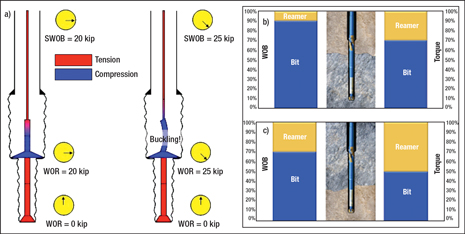 |
|
Fig. 5. a) Illustration of bit and reamer WOB and TOB distribution while drilling non-homogeneous formations; b and c) Illustration of how WOB distribution between the bit and reamer may affect the BHA performance. Courtesy of NOV.
|
|
To address this problem, software has been developed that allows a logical and quantitative approach to bit matching with reamers. The NOV SystemMatched Reamer Tool is unique software that uses an extensive database containing logic tables that describe the multidimensional characteristics of the reamer and the bit.
There are three phases to the tool: definition of the application, selection of the reamer and matching of the drill bit. The selection of the specific reamer by the user allows the matching software to reference a table that lists the key indices for that specific cutting structure. This will include the aggressivity, in terms of both WOB and TOB, as well as the lateral stability and durability indices. With both the application defined and the properties of the reamer, the correct bit can now be selected using the logic tables.
Performance. The software has been successfully used to improve BHA performance in a number of global applications, particularly in the deepwater Gulf of Mexico (GOM). In a Keathley Canyon salt interval in the GOM, a vertical section was drilled with a 14¾-in. M716 drill bit system matched to a 14¾ x 16½-in. hydro-mechanical under-reaming tool. The assembly drilled through this 5,552 ft of predominantly homogenous salt interval in 64.5 hr for an average ROP of 89 ft/hr. The interval was drilled with excellent ROP and displayed very low levels of vibration throughout the run, with both bit and reamer coming out in excellent condition.
Another example of performance was in a directional section in a Green Canyon salt exit in the GOM, building from 5 to 35° inclination, then holding tangent to section TD. The assembly consisted of a 12¼-in. MSR813 bit matched to a 12¼ x 14½-in. hydraulic under-reamer. The section drilled consisted of 2,693 ft through salt, then 2,732 ft of sub-salt sediments, for a total of 5,425 ft, providing an average ROP of 47 ft/hr, though instantaneous ROPs in the salt were more than 90 ft/hr. Hole problems in the subsalt provided lower instantaneous ROPs. Overall, this was an excellent run, with the assembly efficiently delivering the well trajectory and very low vibrations recorded throughout. Bit and reamer displayed excellent dull condition.
In a salt entry in the Keathley Canyon, GOM, a 16½-in. MSR616 bit system was matched to a 16½ X 20-in. hydro-mechanical under-reamer tool. This was a vertical section containing 1,519 ft of pre-salt sediments, then 2,060 ft of salt. The section was drilled in 62.5 hr for an average ROP of 57 ft/hr, again achieving an excellent run in terms of ROP, low levels of vibration, excellent dull condition and good directional control.
SMITH BITS
Smith Bits is addressing the inherent limitation of the fixed PDC shearing element—only a small portion of the cutter’s edge contacts the formation. As the cutters wear and chip due to mechanical/thermal effects, they quickly lose shearing efficiency and the bit must be tripped out of the hole. The industry would benefit from new technology that enables the cutter to rotate while drilling to effectively utilize the entire diamond table. This would reduce frictional heat and wear while increasing overall efficiency and bit life.
Smith Bits, which was purchased by Schlumberger this year, is investigating different cutter retention methods and back-rake/side-rake angles that would create optimal side force to rotate the cutter. An innovative sleeved design was created that holds the cutter securely in place and allows brazing to the bit body. A diagonal cutaway exposes the sharp diamond table and tungsten carbide substrate to the formation.
Quantitative lab testing has yielded positive results. In a single cutter test apparatus, the new rotating shearing element was able to cut 3,750 ft of rock with consistent force. Conversely, the fixed cutter control test required steadily increased force to drive the cutter the same distance, Fig. 6. End-of-test force for the fixed cutter was 450 lb. Average end-of-test force for the new rolling cutter was just 175 lb. In another laboratory test, the fixed element displayed significant wear after cutting just 316 in.3 of rock. Under the same test parameters, the rotating cutter was able to shear 452 in.3 of formation and still remain in good working condition.
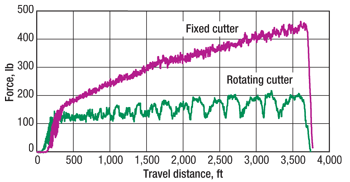 |
|
Fig. 6. In single cutter tests, the rotating cutter demonstrated greater efficiency than the fixed shearing element.
|
|
Modeling. The new rolling cutter and bit design was tested using Smith’s Integrated Dynamic Engineering Analysis System (IDEAS), a comprehensive time-based 4D modeling tool that predicts the bit’s performance and behavior using finite element analysis, laboratory-derived drilling mechanics and physical input data that accurately characterizes the attributes of the total drilling system.
Based on modeling results and successful laboratory testing, a 6⅛-in. six-bladed prototype PDC bit (MSi613) was manufactured with three rolling cutters strategically positioned in the shoulder area. The bit was run in several abrasive (Granite Wash) Texas Panhandle horizontal applications on a steerable motor with good results. The next prototype was equipped with six rotating shearing elements (Fig. 7) and drilled the second-longest run in the offset range.
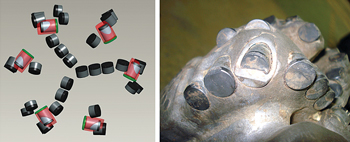 |
|
Fig. 7. New Smith PDC bit design (MSi613) with six rotating cutters in shoulder area.
|
|
Additional experiments with rolling cutter count and placement will continue to further increase drilling performance in difficult drilling environments. When optimized cutter count and placement are achieved, Smith Bits will launch a new PDC product line to improve project economics and reduce overall drilling costs.
VAREL INTERNATIONAL
The development of multiple shale plays worldwide is a major driver in Varel’s bit development. In addition, increasing directional drilling, both on motor and using rotary steerables, and HPHT wells continue to drive refinements. Varel recently introduced breakthrough testing and qualification standards leading to the establishment of two classes of Varel-qualified PDC cutters: Thor and Vulcan. Varel’s Thor-class cutters are engineered to be more impact resistant than standard cutters to address the challenges specific to hard rock applications and interbedded formations where cutter toughness is required. Conversely, highly resistant to abrasion and the heat of drilling, Varel’s Vulcan-class cutters are applied in the hardest and most abrasive drilling applications.
Drilling through transitional zones often produces significant drillstring vibrations. With maximum diamond particle size distribution and optimal sintering, Thor cutters have increased toughness while maintaining thermal mechanical abrasion resistance. With Thor cutters, the foundation of the cutting structure is protected, leading to increased ROP and extended drill bit life in hard-to-drill applications.
Varel applies Vulcan-class cutters when a high level of thermo-mechanical abrasion is anticipated. Highly abrasive formations generate elevated friction and heat during drilling, and industry-standard cutters can crack and wear under these conditions. With a smaller diamond grain size and an enhanced thermal stability, Vulcan cutters resist abrasive wear while maintaining toughness, leading to longer bit life and higher ROP throughout the interval.
Performance. In a recent performance review for drilling offshore southern Thailand, Vulcan cutter-equipped PDC drill bits were able to withstand the highly abrasive formations they encountered, including formations with abundant dolomite stringers.
Specifically, two separate seven-bladed Navigator series drill bits earned top remarks of the project from the drilling engineer in charge as “the best bit for the deeper section.” The first bit drilled through the hard and abrasive Benjarong Formation to a total depth of 12,215 ft, delivering superior footage and ROP when compared to the closest offsets. Due to the excellent post-run condition of the drill bit’s cutting structure, it was quickly rerun to drill an additional 1,782 ft for a cumulative footage of 3,261 ft spanning two runs and an ROP that was 122% higher than the closest competitive offset.
A second bit, used in hard and abrasive dolomite cemented sandstone and dolomitic limestone with multiple dolomite stringers, was also noted for its durability and longevity, Fig. 8. While this 8½-in. VRP713PDGX bit delivered similar footage to its non-Vulcan-equipped counterparts, the post-run condition and the estimated 79% increase in ROP made this bit a success. A second run with this same bit in a separate section delivered a run to TD in the same unforgiving formation type.
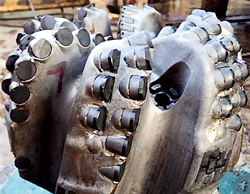 |
|
Fig. 8. Varel’s 8½-in. VRP713PDGX bit, after two complete runs, the most recent being to section TD in a formation consisting of hard and abrasive dolomitic cemented sandstone, dolomitic limestone and dolomite stringers.
|
|
ROOM FOR IMPROVEMENT?
Even with all these bit product developments, there is still room for improvement. As one provider says, “We have come a long way in understanding bit interaction and rock analytics, but there are still advancements available. These include not only design and analytics, but also fundamental materials improvements in PDC cutters, steel metallurgy and tungsten carbide components.” 
Editor’s note: World Oil is not responsible for performance claims made by the manufacturers and vendors herein.
|










